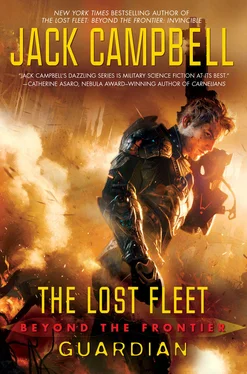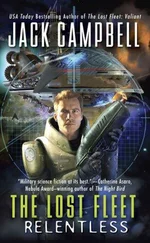“Do you think the Syndics could find twenty maniacs willing to die for their CEOs?” Desjani asked. “Or some poor saps given a chance to wipe out their family’s debt or get a relative out of a death sentence at one of the Syndic labor camps? I don’t know. I do know the Syndics have often shown the willingness to sacrifice their ‘workers’ at the drop of a hat. It’s a suicide attack. That’s how the Syndics are balancing the odds since you beat the hell out of them using conventional tactics. Is there any other possible mission those ships coming at us could be carrying out?”
“No.” And at the rate they were coming, those ships would be plunging into his formation in about twenty minutes.
According to the terms of the peace treaty with the Syndicate Worlds, he couldn’t simply fire on unarmed ships broadcasting merchant identification. Geary didn’t bother saying that. Tanya knew it, and so did everybody else. Including the Syndic leaders who had ordered this operation. If those leaders had expected him to hesitate, to question what to do under these circumstances, they had made a mistake. “Those ships are operating in an aggressive and dangerous manner,” Geary announced for the benefit of the official record. “We have a right to act in self-defense. Broadcast a warning that any ship entering the weapons engagement zone for any of our ships will be fired upon. Repeat the broadcast eight times, on all standard safety and coordination circuits.”
As Desjani’s comm watch-stander scrambled to get that sent, Geary tapped his fleetwide comm control again. “All units in the First Fleet. The twenty-three courier ships accelerating toward an intercept with our formation have been warned to stay clear of us. If they continue on tracks toward us, they are to be regarded as hostile. Any of them that enter your weapons engagement envelopes are to be engaged with all weapons until disabled or destroyed.”
Another call, this time internal. “Emissary Rione and Emissary Charban, tell the Dancers that these ships are dangerous. Say they’re out of control, say they’re hostile, say whatever works to convince the Dancers that those courier ships might collide with them unless the Dancers evade for all they are worth.”
Rione answered, her voice tinged with resignation. “We will try. Even at the best of times, with all the time in the world, the Dancers don’t always listen to us. But we will try.”
“Thank you,” Geary said, putting feeling into the words.
“Lock weapons on those ships and prepare to engage,” Desjani told her crew, then gave Geary a measured look. “Just like old times. Kill the Syndics before they kill us. But. The Syndics know the odds of those ships getting through our defensive fire if they’re not moving fast enough. They’ll accelerate to the maximum velocity they can in the time and distance available in order to screw with our firing solutions.”
He grunted a vague reply as he frowned at his display. The courier ships were simply small crew, storage, and command compartments fastened to the front of outsized main propulsion units and a power core suitable for a ship twice their size. Built to move fast, they were already up to point one light speed and still accelerating.
In jump space, human ships did not actually travel faster than light. They went around that speed limit by going somewhere else, a different dimension or different universe. The experts still didn’t know which of those jump space represented, but they did know that jump space was a place where distances were much smaller than in our own universe. A week in jump space would take a ship the same distance as years of travel in normal space. Oddly enough, it didn’t matter how fast a ship was going when it entered and exited jump space. The length of the journey depended solely on the distance to be covered.
A hypernet avoided light-speed problems by another method, using quantum physics, which literally tossed human craft into a bubble of nothing that was nowhere, created at one gate and eventually reappearing at another linked gate without technically moving.
Both of those things were weird.
But what happened when human spacecraft pushed their velocities higher and higher in normal space was even weirder. Relativity had predicted the strange physical results long before humans could experience them. Objects accelerating toward light speed gained mass while time slowed inside them, all relative to the outside world. To an outside observer, the objects also got shorter as they moved faster. In theory, at the speed of light, the outside universe would see a ship with infinite mass, zero length, and no time passing inside it.
To those inside the ship, length and mass and time all seemed the same as always, but their vision of the outside would alter. The universe outside their ship grew more distorted to them the faster they went. This relativistic distortion became a significant problem at point one light speed, though human-designed sensors and combat systems could compensate accurately for relativistic errors up to point two light speed. Beyond that, the errors grew too large for existing human technology to compensate for, and the already incredibly difficult problem of hitting an object flying past at tens of thousands of kilometers a second became what fleet engineers described using the technical term TDH, which stood for Too Damned Hard.
Based on the projections of the fleet combat systems, those courier ships would have accelerated up past point two light speed by the time they got close enough for the weapons of Geary’s warships to fire at. Since Geary’s own ships were still moving at nearly point one light speed, that would produce a closing rate exceeding point three light speed, drastically impacting the accuracy of weapons fire.
Desjani bit her lip and shook her head. “We could slow down to reduce the relative velocity, but that would make it harder for our ships to evade any attempts at ramming.”
He nodded. “We’d have to go to a dead stop to get the relative speed of engagement down to point two light, and there’s not enough time to slow the fleet that much even if we wanted to do that. If we keep our velocity up, it will make scoring hits a lot harder, but make dodging attacks easier, and the courier ships will have more difficulty hitting their own targets. I’m going to accelerate at the last minute. The extra velocity won’t cause more accuracy problems than we’re already going to face, and might throw off the ramming courses of the courier ships.”
Those small courier ships were still coming, still accelerating, and the projected paths for the Syndic “merchant” craft were now, without doubt, aimed straight into the heart of the Alliance formation, where Invincible made perhaps the largest sitting duck in history. Are they aiming for Invincible ? Or for the Dancers who, for their own reasons, have been clustered near Invincible lately? Or for the assault transports and auxiliaries, which are also in that part of the formation? There are enough of those couriers to target almost all of them. “All units in First Fleet, the ships heading for us are assessed to be on suicide runs. Vary vectors at random intervals to confuse their attack runs, and make wider individual vector changes when it’s too late for the attacker to compensate. All units, screen the assault transports, auxiliaries, and Invincible .”
“You’ve done all you can,” Desjani murmured, her gaze riveted on her display.
“It’s not enough.”
“That depends how you define ‘enough.’” Her eyes moved to meet his. “We used to lose half of our ships when we won . We may lose some now. That’s up to the living stars and the skill of each ship’s commanding officer.”
Читать дальше
Конец ознакомительного отрывка
Купить книгу












